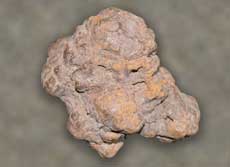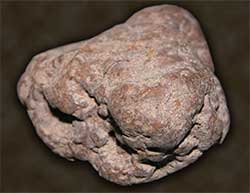Dinosaur Dung - Coprolites
As fossils, dinosaur dung becomes geological records of biological activity. It is organic material produced by the organism that becomes fossilized droppings called coprolites. Not being body fossils of the dinosaurs themselves such as bones or other body parts, they are trace fossils, left behind to become a rare and valuable record for paleontologists, rare because normally they are easily fragmented and destroyed with little chance of becoming fossilized. Coprolites can show what dinosaurs ate and give the structure of the lower digestive tract and the size of the anus. Although coprolites show dinosaur behavior through diet, they fall short of positively confirming dinosaur identification.
 Coprolites, derived from the Greek words kopros meaning 'dung' and lithos meaning
'stone', range in size from a few millimeters to over 60 centimeters with annular
markings or spiral patterns or in shapes similar to eggs or small inorganic pellets.
They can be analyzed for minerals known to exist in ancient species of plants
detecting an herbivore or if bones or other food fragments are present showing a
carnivore. Most coprolites are primarily composed of calcium phosphate with minor
quantities of organic matter. Coprolites were mined on an industrial scale in 19th
century England for use as fertilizer and again during the First World War to
provide phosphates for munitions.
Coprolites, derived from the Greek words kopros meaning 'dung' and lithos meaning
'stone', range in size from a few millimeters to over 60 centimeters with annular
markings or spiral patterns or in shapes similar to eggs or small inorganic pellets.
They can be analyzed for minerals known to exist in ancient species of plants
detecting an herbivore or if bones or other food fragments are present showing a
carnivore. Most coprolites are primarily composed of calcium phosphate with minor
quantities of organic matter. Coprolites were mined on an industrial scale in 19th
century England for use as fertilizer and again during the First World War to
provide phosphates for munitions.
Coprolites are frequently associated with dung beetles. Dung beetles are some of many organisms that feed on the nutrients in feces to decompose it back into the ecosystems in the biogeochemical cycle. In its pre-fossilized state it may contain as much as 50% of the energy of the original food. Dung beetles burrowed under the dinosaur feces and filled their burrows with dung.
